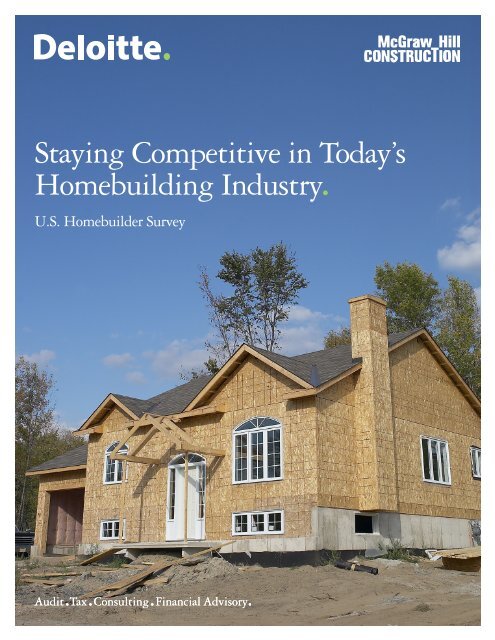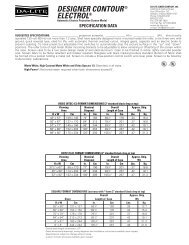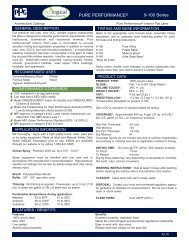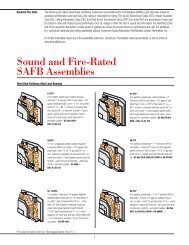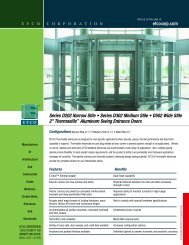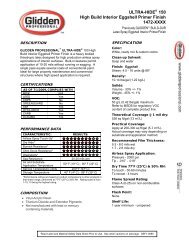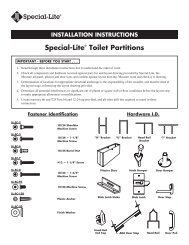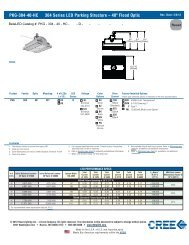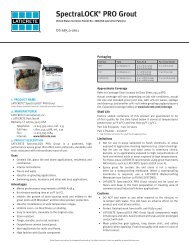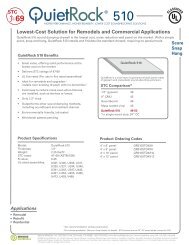Staying Competitive in Today's Homebuilding Industry.
Staying Competitive in Today's Homebuilding Industry.
Staying Competitive in Today's Homebuilding Industry.
You also want an ePaper? Increase the reach of your titles
YUMPU automatically turns print PDFs into web optimized ePapers that Google loves.
<strong>Stay<strong>in</strong>g</strong> <strong>Competitive</strong> <strong>in</strong> Today’s<br />
Homebuild<strong>in</strong>g <strong>Industry</strong>.<br />
U.S. Homebuilder Survey
<strong>Stay<strong>in</strong>g</strong> <strong>Competitive</strong> <strong>in</strong> Today’s Homebuild<strong>in</strong>g <strong>Industry</strong><br />
Deloitte and McGraw-Hill Construction • U.S. Homebuilder Survey<br />
A Survey of Homebuilders<br />
by Deloitte and<br />
McGraw-Hill Construction<br />
Deloitte & McGraw-Hill Construction conducted a study of<br />
homebuilders with the goal of highlight<strong>in</strong>g the dynamics and<br />
challenges that large and small residential construction companies<br />
face. Our survey reveals how homebuilders are navigat<strong>in</strong>g a strong<br />
hous<strong>in</strong>g market - not only to drive sales and expand marg<strong>in</strong>s - but<br />
to keep current on market trends, devise strategies to deal with an<br />
<strong>in</strong>creas<strong>in</strong>gly constricted land supply, and adapt bus<strong>in</strong>ess models to<br />
susta<strong>in</strong> the <strong>in</strong>dustry’s growth.<br />
Highlights<br />
The hous<strong>in</strong>g market has been <strong>in</strong> a susta<strong>in</strong>ed<br />
growth pattern s<strong>in</strong>ce 1992. Perhaps the<br />
most notable aspect of this expansion is that,<br />
<strong>in</strong>stead of decl<strong>in</strong><strong>in</strong>g dur<strong>in</strong>g an economic<br />
recession, homebuild<strong>in</strong>g, home sales,<br />
and home remodel<strong>in</strong>g helped susta<strong>in</strong> the<br />
economy dur<strong>in</strong>g the recent downturn. The<br />
contribut<strong>in</strong>g factor to this unusual resilience<br />
was a drop <strong>in</strong> mortgage <strong>in</strong>terest rates to<br />
46-year lows.<br />
The momentum cont<strong>in</strong>ued through the<br />
first half of 2005. Both new home starts<br />
and pric<strong>in</strong>g rates cont<strong>in</strong>ued on a positive<br />
trajectory. Accord<strong>in</strong>g to the National<br />
Association of Realtors, 4.8 million exist<strong>in</strong>g<br />
homes changed hands through August<br />
2005, sett<strong>in</strong>g the stage for the market to<br />
sell a record 7.3 million homes by the end of<br />
2005. And, while the <strong>in</strong>dustry’s profit marg<strong>in</strong>s<br />
have shown no signs of contract<strong>in</strong>g recent<br />
fluctuations <strong>in</strong> materials and fuel costs, as<br />
well as other economic uncerta<strong>in</strong>ties may<br />
lead to slower growth.
In the midst of impressive <strong>in</strong>dustry growth it is difficult to take the<br />
doom and gloom of a bust too seriously, especially when <strong>in</strong>terest<br />
rates cont<strong>in</strong>ue to rema<strong>in</strong> historically low. Still, some analysts<br />
ma<strong>in</strong>ta<strong>in</strong> that a comb<strong>in</strong>ation of rapidly ris<strong>in</strong>g <strong>in</strong>ventory of new<br />
homes and records for hous<strong>in</strong>g starts would <strong>in</strong>dicate the bubble’s<br />
impend<strong>in</strong>g rupture.<br />
The follow<strong>in</strong>g chart shows strong stock prices ga<strong>in</strong>s for<br />
homebuilders over the last several years.<br />
90<br />
80<br />
70<br />
60<br />
50<br />
40<br />
30<br />
20<br />
10<br />
0<br />
Oct-95<br />
Apr-96<br />
Oct-96<br />
Apr-97<br />
Oct 97<br />
Apr-98<br />
Oct-98<br />
Apr-99<br />
Oct-99<br />
Apr-00<br />
Oct-00<br />
Apr-01<br />
Oct-01<br />
Apr-02<br />
Oct-02<br />
Apr-03<br />
<strong>Stay<strong>in</strong>g</strong> <strong>Competitive</strong> <strong>in</strong> Today’s Homebuild<strong>in</strong>g <strong>Industry</strong><br />
Deloitte and McGraw-Hill Construction • U.S. Homebuilder Survey<br />
Oct-03<br />
Apr-04<br />
Oct-04<br />
Apr-05<br />
Oct-05<br />
len tol kbh hov phm ctx bzh dhi ryl<br />
*NOTE: The Clos<strong>in</strong>g Price, Day’s High, Day’s Low, and Day’s Volume have been adjusted to account for any stock splits and/or<br />
dividends which may have occurred for this security s<strong>in</strong>ce the date shown above.<br />
<strong>Industry</strong> analysts th<strong>in</strong>k hurricane Katr<strong>in</strong>a’s<br />
impact on build<strong>in</strong>g is temporary, despite<br />
a spike <strong>in</strong> nationwide market prices for<br />
lumber and plywood. Homebuilders see<br />
transportation costs likely to rise because<br />
of oil price <strong>in</strong>creases and a tight labor pool<br />
should workers relocate when the Gulf Coast<br />
cities start to rebuild.<br />
Hous<strong>in</strong>g starts over the past five years have<br />
been runn<strong>in</strong>g slightly below the rate set <strong>in</strong><br />
the 1970s, when the U.S. population was 30<br />
percent lower and immigration rates were<br />
50 percent less than what they are today. In<br />
the current climate, a moderate slowdown<br />
<strong>in</strong> certa<strong>in</strong> regions of the U.S. hous<strong>in</strong>g market<br />
appears more probable than a deep-seated<br />
recession <strong>in</strong> the general hous<strong>in</strong>g market.<br />
What are the key questions that<br />
homebuilders are ask<strong>in</strong>g themselves<br />
as they relish the boom and dispel<br />
concerns about the bust?<br />
1. What is our plan for growth?<br />
2. As the <strong>in</strong>dustry consolidates, will we be<br />
acquir<strong>in</strong>g or acquired?<br />
3. What is the best way for us to keep<br />
abreast of what is happen<strong>in</strong>g <strong>in</strong> our<br />
<strong>in</strong>dustry?<br />
4. How do we use technology to improve<br />
our efficiency and competitiveness <strong>in</strong><br />
the marketplace?<br />
5. How can we take advantage of<br />
outsourc<strong>in</strong>g services to reduce costs?<br />
6. How do we deal with issues that delay<br />
production?<br />
7. When land supply is an issue, how do<br />
we adjust our project development?<br />
8. Are we spend<strong>in</strong>g too much on land<br />
development?<br />
9. How do we reduce our build<strong>in</strong>g cycle<br />
time, budget variance, and defects?<br />
10. What operational issues can we address<br />
to <strong>in</strong>crease our efficiency?<br />
11. Do we need to look elsewhere for home<br />
design ideas?<br />
12. Where <strong>in</strong> our supply cha<strong>in</strong> can we f<strong>in</strong>d<br />
additional cost sav<strong>in</strong>gs?<br />
13. Are we prepared for the affect of GAAP<br />
report<strong>in</strong>g under FIN 46?<br />
14. Which market<strong>in</strong>g approaches will drive<br />
the most sales?<br />
15. How do we respond to customer desires<br />
relat<strong>in</strong>g to home customizations and<br />
the environment?
<strong>Stay<strong>in</strong>g</strong> <strong>Competitive</strong> <strong>in</strong> Today’s Homebuild<strong>in</strong>g <strong>Industry</strong><br />
Deloitte and McGraw-Hill Construction • U.S. Homebuilder Survey<br />
Homebuild<strong>in</strong>g <strong>Industry</strong> –<br />
Susta<strong>in</strong><strong>in</strong>g the Recent Success<br />
Accord<strong>in</strong>g to data reported by the Bureau of Census and the National Association of Realtors, there are approximately 120 million<br />
homes <strong>in</strong> the U.S., and about 1.5 million new s<strong>in</strong>gle-family homes are added to the stock each year.<br />
In 2004, there were 1.6 million s<strong>in</strong>gle-family homes started (versus 1.2 million sold), and 350,000 multifamily starts. The median price for new<br />
s<strong>in</strong>gle-family homes reached $221,000 <strong>in</strong> 2004, compared with $184,000 for exist<strong>in</strong>g homes. The average size of a home cont<strong>in</strong>ues to grow<br />
steadily, reach<strong>in</strong>g a median square footage of 2,162 <strong>in</strong> 2004, compared with 1,535 <strong>in</strong> 1975.<br />
<strong>Industry</strong>’s Significant Factors<br />
The key driver <strong>in</strong> homebuild<strong>in</strong>g is the<br />
level and direction of <strong>in</strong>terest rates. Other<br />
significant factors that drive cycles with<strong>in</strong> the<br />
<strong>in</strong>dustry are supply and demand, pric<strong>in</strong>g, and<br />
the availability of rental units. The market<br />
is also impacted by employment trends,<br />
consumer confidence levels, and hous<strong>in</strong>g<br />
prices. The availability of mortgage capital<br />
also plays an important role <strong>in</strong> susta<strong>in</strong><strong>in</strong>g<br />
consumer demand.<br />
Although <strong>in</strong>terest rates and the number<br />
of new hous<strong>in</strong>g starts are among the<br />
most visible factors shap<strong>in</strong>g demand, the<br />
structure of the <strong>in</strong>dustry itself is the most<br />
salient determ<strong>in</strong>ant of economic value.<br />
Indisputably, the homebuild<strong>in</strong>g <strong>in</strong>dustry<br />
structure is becom<strong>in</strong>g <strong>in</strong>creas<strong>in</strong>gly attractive.<br />
Fundamental long-term demand for hous<strong>in</strong>g<br />
rema<strong>in</strong>s strong. Population growth, real<br />
<strong>in</strong>come levels, and the age of households<br />
are among the prom<strong>in</strong>ent variables likely to<br />
positively <strong>in</strong>fluence the homebuild<strong>in</strong>g <strong>in</strong>dustry<br />
over the next few years. Less visible trends<br />
<strong>in</strong>clude <strong>in</strong>tensify<strong>in</strong>g barriers to <strong>in</strong>dustry entry.<br />
Complexity of development and economies<br />
of scale <strong>in</strong> capital access and materials<br />
procurement are mak<strong>in</strong>g it more difficult for<br />
new players to enter the market. The rivalry<br />
among exist<strong>in</strong>g competitors is also <strong>in</strong>creas<strong>in</strong>g.<br />
Not only are large builders ga<strong>in</strong><strong>in</strong>g market<br />
share, they are compet<strong>in</strong>g head-to-head <strong>in</strong> a<br />
grow<strong>in</strong>g number of markets.<br />
Land is the Differentiator<br />
Land is the most important commodity <strong>in</strong> the<br />
homebuild<strong>in</strong>g bus<strong>in</strong>ess. Land is becom<strong>in</strong>g<br />
<strong>in</strong>creas<strong>in</strong>gly scarce, especially <strong>in</strong> hot markets,<br />
and correspond<strong>in</strong>gly, land is becom<strong>in</strong>g more<br />
important to the buyer than the features of<br />
the new house alone. The result of these<br />
trends is superior profitability <strong>in</strong> the <strong>in</strong>dustry,<br />
especially for large regional and national<br />
builders. Despite strong consumer demand<br />
for hous<strong>in</strong>g, the supply of land for home<br />
build<strong>in</strong>g is limited. Builders are fac<strong>in</strong>g a<br />
critical shortage of developable land. As a<br />
result, the cost of land has soared <strong>in</strong> many<br />
regions of the country. Builders are locked<br />
<strong>in</strong> bidd<strong>in</strong>g wars. Local governments are<br />
promulgat<strong>in</strong>g more and more land use<br />
regulation as they attempt to foster “smart<br />
growth.” Governments are lengthen<strong>in</strong>g<br />
the permit approval process, preserv<strong>in</strong>g<br />
land for conservation, and m<strong>in</strong>imiz<strong>in</strong>g<br />
residential growth by impos<strong>in</strong>g moratoriums<br />
on development. In some markets, threefourths<br />
of home price appreciation growth<br />
can be attributed to land-use regulations,<br />
accord<strong>in</strong>g to Fisher Center for Real Estate<br />
and Urban Economics Chairman Kenneth<br />
Rosen. Regulations are limit<strong>in</strong>g the amount of<br />
developable land and <strong>in</strong>creas<strong>in</strong>g the costs of<br />
that land<br />
<strong>Industry</strong> Consolidation<br />
– Threat or Opportunity?<br />
In addition to limitations on the supply of<br />
land, bus<strong>in</strong>ess growth and the prospect<br />
of consolidation are major issues for<br />
homebuilders. When growth is limited<br />
<strong>in</strong> currently served markets due to land<br />
restra<strong>in</strong>ts or competition, one way to grow is<br />
to expand <strong>in</strong> new markets, by either seek<strong>in</strong>g<br />
bus<strong>in</strong>ess <strong>in</strong> a new geographic area or by<br />
tak<strong>in</strong>g over another firm <strong>in</strong> a different region.<br />
For dozens of years now, large public builders<br />
have been devour<strong>in</strong>g smaller private builders<br />
<strong>in</strong> an effort to susta<strong>in</strong> pric<strong>in</strong>g power and<br />
<strong>in</strong>crease their supply of buildable land. The<br />
trend toward consolidation shows no sign of<br />
abat<strong>in</strong>g any time soon.<br />
The follow<strong>in</strong>g summarizes the critical issues<br />
us<strong>in</strong>g <strong>in</strong>formation gathered from our survey<br />
of homebuilders and lot developers, as<br />
well as our cont<strong>in</strong>uous monitor<strong>in</strong>g of the<br />
real estate markets.
Who We Surveyed <br />
• Homebuilders or lot developers<br />
97% of our respondents<br />
• Privately held companies<br />
94% of our respondents<br />
• Annual revenues of greater than $100M<br />
34% of our respondents<br />
• Build more than 250 homes per year<br />
29% of our respondents<br />
Respondents by Profession<br />
<br />
<br />
<br />
<br />
<br />
<br />
<br />
<br />
<br />
<br />
<br />
<strong>Stay<strong>in</strong>g</strong> <strong>Competitive</strong> <strong>in</strong> Today’s Homebuild<strong>in</strong>g <strong>Industry</strong><br />
Deloitte and McGraw-Hill Construction • U.S. Homebuilder Survey<br />
<br />
<br />
<br />
<br />
<br />
<br />
<br />
<br />
Revenue Distribution of Respondents
<strong>Stay<strong>in</strong>g</strong> <strong>Competitive</strong> <strong>in</strong> Today’s Homebuild<strong>in</strong>g <strong>Industry</strong><br />
Deloitte and McGraw-Hill Construction • U.S. Homebuilder Survey<br />
What They Build<br />
How Many They Build<br />
Residential Builds By Type<br />
Residential Construction by Respondents, by Type<br />
<br />
Starter<br />
22%<br />
Luxury<br />
11%<br />
Other<br />
4%<br />
Move–Up<br />
63%<br />
<br />
Number of New Homes Built <strong>in</strong> 2004 by Respondents
Percent of Homes Pre-Sold<br />
<strong>Stay<strong>in</strong>g</strong> <strong>Competitive</strong> <strong>in</strong> Today’s Homebuild<strong>in</strong>g <strong>Industry</strong><br />
Deloitte and McGraw-Hill Construction • U.S. Homebuilder Survey<br />
Where They Build<br />
2004 Total New Home Construction by Region<br />
The U.S. hous<strong>in</strong>g market is <strong>in</strong>herently<br />
regional, and our survey results reflect the<br />
broader nationwide statistics on hous<strong>in</strong>g<br />
construction. Respondents are build<strong>in</strong>g<br />
more units <strong>in</strong> the south and southwest.<br />
Hot markets <strong>in</strong>clude Phoenix, Las Vegas,<br />
California, and Florida.<br />
Percent of Builders Pre-Sell What Percent of Homes<br />
Percentage of New Homes Pre-Sold by Respondents<br />
% of Builders<br />
# Units<br />
50%<br />
40%<br />
30%<br />
20%<br />
10%<br />
0%<br />
Respondents’ 2004 Total New Home Construction by Region<br />
16,000<br />
14,000<br />
12,000<br />
10,000<br />
8,000<br />
6,000<br />
4,000<br />
2,000<br />
Less than<br />
75%<br />
0<br />
Southwest<br />
75 to<br />
80%<br />
80 to<br />
85%<br />
Southeast<br />
85 to<br />
90%<br />
% of Homes Pre-Sold<br />
Midwest<br />
90 to<br />
95%<br />
Northeast<br />
Over<br />
95%<br />
Northwest
<strong>Stay<strong>in</strong>g</strong> <strong>Competitive</strong> <strong>in</strong> Today’s Homebuild<strong>in</strong>g <strong>Industry</strong><br />
Deloitte and McGraw-Hill Construction • U.S. Homebuilder Survey<br />
The Price of New Homes<br />
New homes along the east and west coasts are more expensive than <strong>in</strong> other areas of the country, regardless of the type of home, whether it is a<br />
starter, move-up, or luxury home.<br />
National<br />
Average<br />
Northeast California<br />
Starter $188,022 $266,250 $358,333<br />
Move Up $304,792 $420,667 $535,125<br />
Luxury $855,074 $995,000 $1,596,667<br />
Among our respondents, not surpris<strong>in</strong>gly, customization occurs at the high-end of the home spectrum. Nearly 70% of move-up, luxury, and<br />
retirement homes were custom built, compared to 52% of vacation homes and only 26% of starter homes.<br />
Average Price Per Region by Build Type<br />
Region Starter Move-Up Luxury<br />
California $358,333 $535,125 $1,596,667<br />
Northeast $266,250 $420,667 $995,000<br />
Nat’l Average $188,022 $304,792 $855,074<br />
Midwest $172,143 $284,647 $502,727<br />
Northwest $167,600 $261,000 $650,000<br />
Southwest $141,167 $207,429 $945,000<br />
Florida $136,667 $298,889 $743,750<br />
Texas $131,400 $203,875 $468,000<br />
Southeast $130,615 $226,706 $939,444
Rid<strong>in</strong>g out the Boom<br />
What is our plan for growth?<br />
The hous<strong>in</strong>g market rema<strong>in</strong>s <strong>in</strong> the thick of an<br />
upturn that began more than a decade ago.<br />
Consumer demand – fueled by low <strong>in</strong>terest<br />
rates, accessible credit, and m<strong>in</strong>imal <strong>in</strong>flation<br />
– rema<strong>in</strong>s strong. The convergence of<br />
favorable economics and <strong>in</strong>creas<strong>in</strong>g f<strong>in</strong>ancial<br />
wherewithal sets the stage for nearly every<br />
type of home builder to benefit from positive<br />
demographic and f<strong>in</strong>ancial trends.<br />
The demand for hous<strong>in</strong>g rema<strong>in</strong>s on an<br />
upward trajectory, with demographers<br />
estimat<strong>in</strong>g an average annual addition of<br />
1.5 million households <strong>in</strong> the United States<br />
for the next 15 years.<br />
• Baby Boomers, the demographic sector<br />
that has shaped the home-build<strong>in</strong>g market<br />
at each stage of their lives, are expected to<br />
create a significant <strong>in</strong>crease <strong>in</strong> demand for<br />
hous<strong>in</strong>g <strong>in</strong> retirement and age-restricted<br />
communities. Younger Baby Boomers (<strong>in</strong><br />
their 40s) are mov<strong>in</strong>g up to larger, pricier<br />
primary homes, and many are purchas<strong>in</strong>g<br />
second or vacation homes as well.<br />
• Children of Baby Boomers, or Echo<br />
Boomers, are just beg<strong>in</strong>n<strong>in</strong>g to enter the<br />
hous<strong>in</strong>g market and are expected to drive<br />
demand even further.<br />
<strong>Stay<strong>in</strong>g</strong> <strong>Competitive</strong> <strong>in</strong> Today’s Homebuild<strong>in</strong>g <strong>Industry</strong><br />
Deloitte and McGraw-Hill Construction • U.S. Homebuilder Survey<br />
• Accord<strong>in</strong>g to the U.S. Census Bureau, more<br />
than one million immigrants flock <strong>in</strong>to the<br />
U.S. each year. In fact, immigration levels<br />
have been much higher than estimates<br />
projected by the National Association of<br />
Homebuilders. The unanticipated rise <strong>in</strong><br />
immigration levels coupled with a trend<br />
for immigrants to purchase homes sooner<br />
upon relocation to the U.S. is cont<strong>in</strong>u<strong>in</strong>g to<br />
fuel new home demand.<br />
• In sum, Echo Boomers and immigrants are<br />
the two demographic segments expected<br />
to lead overall growth <strong>in</strong> the number of<br />
households over the next decade. Both<br />
groups are also likely to afford a secure<br />
market for older homeowners to sell their<br />
first homes and move up to higher-priced<br />
second and luxury homes.
<strong>Stay<strong>in</strong>g</strong> <strong>Competitive</strong> <strong>in</strong> Today’s Homebuild<strong>in</strong>g <strong>Industry</strong><br />
Deloitte and McGraw-Hill Construction • U.S. Homebuilder Survey<br />
Tak<strong>in</strong>g Acquisitive Action<br />
As the <strong>in</strong>dustry consolidates, will we be acquir<strong>in</strong>g or will we be<br />
acquired?<br />
Consolidation is affect<strong>in</strong>g the structure of<br />
the homebuild<strong>in</strong>g <strong>in</strong>dustry. Homebuilders<br />
concerned about growth are f<strong>in</strong>d<strong>in</strong>g the<br />
best way to expand successfully and meet a<br />
nearly <strong>in</strong>satiable consumer demand for new<br />
homes is to acquire other builders. Large<br />
homebuilders enjoy materials and labor<br />
cost advantages relative to small builders, <strong>in</strong><br />
addition to superior access to capital. Recently<br />
announced deals <strong>in</strong>clude Lennar Corp.’s plans<br />
to acquire the Lamplight Homes division of<br />
Las Vegas-based Car<strong>in</strong>a Corp. and Hovnanian<br />
Enterprises, Inc.’s acquisition of Oster Homes.<br />
Technical Olympic USA, Inc. also completed<br />
its acquisition of the homebuild<strong>in</strong>g assets and<br />
operations of Transeastern Properties, Inc.<br />
Accord<strong>in</strong>g to Mergerstat, there were over two<br />
dozen acquisitions <strong>in</strong> 2004 and another 18 so<br />
far <strong>in</strong> 2005.<br />
Rank<br />
Top U.S.<br />
Home Builders<br />
2004<br />
Revenue<br />
($ mil)<br />
1 Pulte Homes, Inc. 11,711.2<br />
2 D.R. Horton Inc. 10,840.8<br />
3 Lennar Corporation 10,504.9<br />
4 Centex Corporation 10,363.4<br />
5 KB Home 7,052.7<br />
6 NVR, Inc. 4,327.7<br />
7 Hovnanian Enterprises 4,160.4<br />
8 M.D.C. Hold<strong>in</strong>gs, Inc. 4,009.1<br />
9 The Ryland Group 3,951.8<br />
10 Beazer Homes USA, Inc. 3,907.1<br />
Source: OneSource<br />
More than a dozen acquisitions dur<strong>in</strong>g 2003<br />
resulted <strong>in</strong> the top 10 builders <strong>in</strong>creas<strong>in</strong>g their<br />
total U.S. market share from 10% <strong>in</strong> 1995 to<br />
20% <strong>in</strong> 2004.<br />
The top 100 builders now control<br />
approximately 65 percent of the market.<br />
Some pundits estimate that the top 20<br />
builders will account for 75% of new<br />
construction by 2011.<br />
Small, local and regional builders number <strong>in</strong><br />
thousands across the U.S. While consolidation<br />
has led to expanded territories and revenue<br />
base for the big builders, small, privately held<br />
firms cont<strong>in</strong>ue to lose market share. Critics<br />
contend that the result has been disruption of<br />
local community and market dynamics, and<br />
generic look<strong>in</strong>g homes. Despite the criticism,<br />
the consolidation trend will cont<strong>in</strong>ue. As the<br />
<strong>in</strong>dustry structure becomes more attractive,<br />
homebuilder profitability will favor large<br />
multi-regional players that can leverage<br />
economies of scale <strong>in</strong> materials procurement<br />
and provide greater <strong>in</strong>ventory discipl<strong>in</strong>e.
Keep<strong>in</strong>g up With the Trends<br />
Respondents rely primarily on trade literature<br />
to help them identify and react to develop<strong>in</strong>g<br />
trends <strong>in</strong> the hous<strong>in</strong>g market, with many<br />
respondents us<strong>in</strong>g trade publications<br />
<strong>in</strong>tensively to keep current on <strong>in</strong>dustry news<br />
and trends.<br />
Work<strong>in</strong>g directly with customers and<br />
respond<strong>in</strong>g to their needs and requests<br />
Keep<strong>in</strong>g Current<br />
had the second highest number of positive<br />
responses from our builders.<br />
<strong>Stay<strong>in</strong>g</strong> <strong>Competitive</strong> <strong>in</strong> Today’s Homebuild<strong>in</strong>g <strong>Industry</strong><br />
Deloitte and McGraw-Hill Construction • U.S. Homebuilder Survey<br />
What is the best way to keep abreast of what is happen<strong>in</strong>g <strong>in</strong><br />
our <strong>in</strong>dustry?<br />
Keep<strong>in</strong>g Current<br />
Respondents<br />
60%<br />
50%<br />
40%<br />
30%<br />
20%<br />
10%<br />
0%<br />
Trade<br />
Literature &<br />
Publications<br />
Customer<br />
Requests<br />
In-house/External<br />
Market<br />
Research<br />
Attend<strong>in</strong>g trade shows and conduct<strong>in</strong>g<br />
or us<strong>in</strong>g market research studies were<br />
identified as somewhat less desirable ways<br />
for respondents to keep current with <strong>in</strong>dustry<br />
news and trends. Ostensibly, these two<br />
methods represent the greatest cost <strong>in</strong> terms<br />
of both builders’ time and money.<br />
Trade<br />
Shows<br />
0
<strong>Stay<strong>in</strong>g</strong> <strong>Competitive</strong> <strong>in</strong> Today’s Homebuild<strong>in</strong>g <strong>Industry</strong><br />
Deloitte and McGraw-Hill Construction • U.S. Homebuilder Survey<br />
Comparison of Current Trends Growth<br />
When asked to identify the fastest grow<strong>in</strong>g practices <strong>in</strong> hous<strong>in</strong>g construction, respondents picked the burgeon<strong>in</strong>g selection of<br />
<strong>in</strong>terior amenities as the number one growth area.<br />
Comparison of Current Trends Growth<br />
Respondents<br />
100% Grow<strong>in</strong>g/<br />
Fast Growth<br />
80%<br />
60%<br />
40%<br />
20%<br />
0%<br />
High-End<br />
Kitchen<br />
Materials<br />
Tile<br />
Floor<strong>in</strong>g<br />
Wood<br />
Floor<strong>in</strong>g<br />
Panelized<br />
Home<br />
Modular<br />
Home<br />
Steel<br />
Fram<strong>in</strong>g<br />
Not Grow<strong>in</strong>g/<br />
Slow Growth<br />
Tak<strong>in</strong>g advantage of abundant selections of wood and tile floor<strong>in</strong>g and higher-end kitchen materials selection were by far the<br />
most quickly develop<strong>in</strong>g practices.
Us<strong>in</strong>g Technology<br />
<strong>Stay<strong>in</strong>g</strong> <strong>Competitive</strong> <strong>in</strong> Today’s Homebuild<strong>in</strong>g <strong>Industry</strong><br />
Deloitte and McGraw-Hill Construction • U.S. Homebuilder Survey<br />
How can we use technology to improve our efficiency and<br />
competitiveness <strong>in</strong> the marketplace?<br />
Use of Technology<br />
Despite the cost of <strong>in</strong>vestment, technology is a key factor <strong>in</strong> achiev<strong>in</strong>g operational effectiveness. In fact, all respondents claimed to use<br />
technology to support some aspect of their bus<strong>in</strong>ess. The most popular applications <strong>in</strong>clude f<strong>in</strong>ancial report<strong>in</strong>g software, and technology-based<br />
systems to support corporate purchas<strong>in</strong>g and project management operations.<br />
Use of Technology<br />
Respondents<br />
100%<br />
90%<br />
80%<br />
70%<br />
60%<br />
50%<br />
40%<br />
30%<br />
20%<br />
10%<br />
0%<br />
F<strong>in</strong>ancial<br />
Report<strong>in</strong>g<br />
Purchas<strong>in</strong>g<br />
Project<br />
Management<br />
Operational<br />
Management<br />
Sales<br />
Management<br />
Lead<br />
Track<strong>in</strong>g
<strong>Stay<strong>in</strong>g</strong> <strong>Competitive</strong> <strong>in</strong> Today’s Homebuild<strong>in</strong>g <strong>Industry</strong><br />
Deloitte and McGraw-Hill Construction • U.S. Homebuilder Survey<br />
General operational management systems<br />
are used by more then 50% of survey<br />
respondents. Most builders utilize systems to<br />
support f<strong>in</strong>ancial operations as part of their<br />
firm’s <strong>in</strong>frastructure. Software applications<br />
that are typically considered “back office”<br />
functions – purchas<strong>in</strong>g and project and<br />
operational management – are used to<br />
vary<strong>in</strong>g degrees by more than half of the<br />
respondents.<br />
Other technical-support systems, such as<br />
sales management and lead track<strong>in</strong>g, are less<br />
commonly used by respondents. This may<br />
speak to the strength of the market and the<br />
ability of builders to readily sell their hous<strong>in</strong>g<br />
product, but recent research by J.D. Power &<br />
Associates, another unit of the McGraw-Hill<br />
Companies, found that home builders are<br />
realiz<strong>in</strong>g the benefits of repeat and referral<br />
bus<strong>in</strong>ess from satisfied customers.<br />
With competition fierce among builders, large<br />
builders, especially, are turn<strong>in</strong>g to customer<br />
relationship management systems (CRM)<br />
to support market<strong>in</strong>g and bus<strong>in</strong>ess<br />
development efforts.<br />
Use of Enterprise Resource Plann<strong>in</strong>g (ERP)<br />
systems is an area of great potential for<br />
the <strong>in</strong>dustry as a whole. Only eight of<br />
our respondents were currently us<strong>in</strong>g ERP<br />
systems. These respondents were all identified<br />
as large national builders. While the national<br />
players benefit from ERP systems that help<br />
them keep track of widespread operations<br />
and the distribution of large materials to<br />
many locations, smaller homebuilders, who<br />
often have grown from a sole proprietorship,<br />
may not yet have acquired the scope of<br />
operations or technical <strong>in</strong>frastructure to<br />
harness the advantages of an ERP system.<br />
When it comes to measur<strong>in</strong>g satisfaction with<br />
current technical systems, only 41% of the<br />
respondents agreed that their current systems<br />
were serv<strong>in</strong>g their immediate purposes<br />
“pretty well,” while another 31% said<br />
the systems served their long-term needs<br />
“fairly well.”
Outsourc<strong>in</strong>g<br />
<strong>Stay<strong>in</strong>g</strong> <strong>Competitive</strong> <strong>in</strong> Today’s Homebuild<strong>in</strong>g <strong>Industry</strong><br />
Deloitte and McGraw-Hill Construction • U.S. Homebuilder Survey<br />
How can we take advantage of outsourc<strong>in</strong>g services to reduce costs?<br />
Use of Outsourc<strong>in</strong>g Services<br />
When asked about outsourc<strong>in</strong>g technology services, both hardware and software are outsourced by about 30% of our respondents. In addition<br />
to technology, mortgage orig<strong>in</strong>ation and sales support rank among the most popular avenues for outsourc<strong>in</strong>g among respondents.<br />
Use of Outsourc<strong>in</strong>g Services<br />
Mortgage Orig<strong>in</strong>ation<br />
Technology: Hardware Mgt.<br />
Technology: Software Mgt.<br />
Sales<br />
Market<strong>in</strong>g<br />
Warranty Work<br />
Other<br />
0 10 20 30 40 50 60 70<br />
# Respondents
<strong>Stay<strong>in</strong>g</strong> <strong>Competitive</strong> <strong>in</strong> Today’s Homebuild<strong>in</strong>g <strong>Industry</strong><br />
Deloitte and McGraw-Hill Construction • U.S. Homebuilder Survey<br />
Exam<strong>in</strong><strong>in</strong>g New Home Costs<br />
& Sell<strong>in</strong>g Value Cha<strong>in</strong><br />
Site Acquisition<br />
Key Components of Site Acquisition<br />
• Identify attractive markets<br />
• Buy or secure land<br />
• Procure entitlements and permits<br />
• Prepare land for homebuild<strong>in</strong>g<br />
Site Acquisition<br />
Sales & Market<strong>in</strong>g<br />
Home Design<br />
Construction<br />
For the on-site builder, the first step <strong>in</strong> the<br />
new build<strong>in</strong>g process is choos<strong>in</strong>g an attractive<br />
geographic area and secur<strong>in</strong>g the land or lots<br />
(land which has been developed for build<strong>in</strong>g).<br />
At this stage, the builder must obta<strong>in</strong><br />
environmental and other regulatory approvals.<br />
In the case of a builder construct<strong>in</strong>g a planned<br />
community, approvals also have to be obta<strong>in</strong>ed<br />
for roads, dra<strong>in</strong>age facilities, and sewers.<br />
Builders work closely with local government<br />
officials, and utility officials. The builder usually<br />
buys the land outright, but more builders are<br />
tak<strong>in</strong>g advantage of roll<strong>in</strong>g lot option contracts<br />
which give them the right to buy land at<br />
specified prices on a flexible schedule. This<br />
allows them to pay a smaller amount up front.<br />
Purchase Materials<br />
Account<strong>in</strong>g & F<strong>in</strong>anc<strong>in</strong>g<br />
With respect to the approval process,<br />
restrictive zon<strong>in</strong>g and no-growth or slowgrowth<br />
ord<strong>in</strong>ances can reduce supplies of<br />
available lots for development <strong>in</strong> many metro<br />
markets, driv<strong>in</strong>g up land prices and the<br />
overall cost of homes. In some high-growth<br />
markets, the cost of a developed lot - raw<br />
land and improvements plus fees for basic<br />
<strong>in</strong>frastructure such as schools, roads, and<br />
sewer systems - now accounts for as much as<br />
30% of the new-home price.
Production Roadblocks<br />
How do we deal with issues that delay production?<br />
<strong>Stay<strong>in</strong>g</strong> <strong>Competitive</strong> <strong>in</strong> Today’s Homebuild<strong>in</strong>g <strong>Industry</strong><br />
Deloitte and McGraw-Hill Construction • U.S. Homebuilder Survey<br />
Both the availability of developable land and land-related delays <strong>in</strong> commenc<strong>in</strong>g development are viewed as the most significant barriers to<br />
production. Restrictive Perceived zon<strong>in</strong>g practices Impediments and no-growth to or slow-growth Homebuild<strong>in</strong>g ord<strong>in</strong>ances can Production<br />
dim<strong>in</strong>ish the supplies of available lots for development <strong>in</strong><br />
many metro areas, driv<strong>in</strong>g up land prices as well as the overall cost of homes. In most high growth markets, the cost of a developed lot, which<br />
is def<strong>in</strong>ed as the raw land and improvements plus fees for basic <strong>in</strong>frastructure, such as schools, roads, and sewer systems, may reach as much as<br />
30% of the overall home price.<br />
Perceived Impediments to Homebuild<strong>in</strong>g Production<br />
Masterplan Developers<br />
Material Availability<br />
Build<strong>in</strong>g Codes<br />
Cost of Insurance<br />
Environmental Groups<br />
Local Zon<strong>in</strong>g Restrictions<br />
Government Fees<br />
Infrastructure Support<br />
Land Development Delays<br />
Supply of Developable Land<br />
1 1.5 2 2.5 3 3.5 4 4.5 5<br />
Not important Very important<br />
Average Rat<strong>in</strong>g on 1-5 scale<br />
Many municipalities and local governments<br />
also tack on “impact fees,” <strong>in</strong> addition to<br />
build<strong>in</strong>g permits, to cover the impact of<br />
additional population density on the local<br />
<strong>in</strong>frastructure. These extra fees are <strong>in</strong>tended<br />
to compensate for street and road expansion<br />
and repair, l<strong>in</strong>k<strong>in</strong>g new construction to utility,<br />
water, and sewer systems as well as provid<strong>in</strong>g<br />
for local schools, police and fire coverage and<br />
other municipal services.<br />
Impact fees, which started nearly 30 years<br />
ago with the passage of Proposition 13 <strong>in</strong><br />
California, have been grow<strong>in</strong>g over time and<br />
now the Chicago-based American Plann<strong>in</strong>g<br />
Association puts the national average for<br />
cumulative impact fees at $14,441 per<br />
dwell<strong>in</strong>g unit. These fees can range from just<br />
a few hundred dollars <strong>in</strong> some areas to more<br />
than $100,000 <strong>in</strong> some parts of California.<br />
One study by the U.S. Department of Hous<strong>in</strong>g<br />
and Urban development estimated that<br />
additional fees have added to the cost of new<br />
homes by nearly 35% <strong>in</strong> some areas.
<strong>Stay<strong>in</strong>g</strong> <strong>Competitive</strong> <strong>in</strong> Today’s Homebuild<strong>in</strong>g <strong>Industry</strong><br />
Deloitte and McGraw-Hill Construction • U.S. Homebuilder Survey<br />
The Cost of Land<br />
When land supply is an issue, how do we adjust our project<br />
development?<br />
F<strong>in</strong>ished Land Cost<br />
The cost of land as a percentage of the f<strong>in</strong>al home price is fairly consistent across different types of new homes. The land costs range from 24%<br />
to 28% among starter, move-up, and luxury homes. Not surpris<strong>in</strong>gly, the regions with the highest cost of land, as a percentage of the f<strong>in</strong>al<br />
sale price, <strong>in</strong>clude the Northeast and the Midwest, as well as the states of Florida and California. In all four areas, the cost of land accounts for<br />
approximately 33% of the f<strong>in</strong>ished home cost.<br />
F<strong>in</strong>ished Land Cost<br />
Midwest<br />
Northeast<br />
California<br />
Southeast<br />
National Average<br />
Southwest<br />
Florida<br />
Texas<br />
Northwest<br />
0 5 10 15 20 25 30 35 40<br />
% F<strong>in</strong>al Home Price<br />
Luxury<br />
Move-Up<br />
Starter
Respondents<br />
60%<br />
50%<br />
40%<br />
30%<br />
20%<br />
10%<br />
0%<br />
New multifamily homes constructed by<br />
respondents demonstrated a similar land-tototal<br />
cost ratio. Starter multifamily properties<br />
averaged 24% of total cost to land. For<br />
“move-up” properties, land costs were 26%<br />
of total costs. For luxury properties, land<br />
accounted for 29% of the total f<strong>in</strong>ished<br />
home cost and land for custom-built luxury<br />
homes could reach as much as 50% of the<br />
cost of the f<strong>in</strong>ished home.<br />
When Land Supply is Challenged<br />
When Land Supply is Challenged<br />
Higher<br />
Density<br />
One<br />
Family<br />
Smaller<br />
Lot<br />
Size<br />
Reuse<br />
or<br />
Infill<br />
<strong>Stay<strong>in</strong>g</strong> <strong>Competitive</strong> <strong>in</strong> Today’s Homebuild<strong>in</strong>g <strong>Industry</strong><br />
Deloitte and McGraw-Hill Construction • U.S. Homebuilder Survey<br />
Dur<strong>in</strong>g a hous<strong>in</strong>g boom, builders typically<br />
pass costs associated with land constra<strong>in</strong>ts<br />
along to their buyers; however, there is<br />
concern that as <strong>in</strong>terest rates rise, buyers<br />
will no longer be able to shoulder this<br />
burden. In survey<strong>in</strong>g our respondents about<br />
the limitations on land supply, the majority<br />
suggest that build<strong>in</strong>g larger homes can<br />
compensate for a decrease <strong>in</strong> land availability.<br />
Build<strong>in</strong>g higher density one-family homes or<br />
us<strong>in</strong>g smaller lots were the two most popular<br />
alternatives to tight supply, followed by reuse<br />
or <strong>in</strong>fill.<br />
Higher<br />
Density<br />
Attached<br />
Alter<br />
Geo<br />
Focus
<strong>Stay<strong>in</strong>g</strong> <strong>Competitive</strong> <strong>in</strong> Today’s Homebuild<strong>in</strong>g <strong>Industry</strong><br />
Deloitte and McGraw-Hill Construction • U.S. Homebuilder Survey<br />
Rais<strong>in</strong>g Profits<br />
Are we spend<strong>in</strong>g too much on land development?<br />
The cost of land and land development costs top the Impact list of factors on that negatively Profitability impact profitability. The ease <strong>in</strong> purchas<strong>in</strong>g land and the ability<br />
to control costs <strong>in</strong> the subsequent development of that land are critical factors <strong>in</strong> both the production of new homes and the homebuilder’s<br />
bottom l<strong>in</strong>e. It is <strong>in</strong>terest<strong>in</strong>g to note that while <strong>in</strong>surance costs ranked third <strong>in</strong> terms of their squeeze on profits, respondents viewed these costs<br />
as hav<strong>in</strong>g less impact on actual homebuild<strong>in</strong>g production.<br />
Costs Impact on Profitability<br />
Property Tax Rate<br />
F<strong>in</strong>anc<strong>in</strong>g<br />
Workers’ Compensation<br />
Availability of Qualified Subcontractors<br />
Materials<br />
Permits & Fees<br />
Insurance<br />
Land Development<br />
Land<br />
1 1.5 2 2.5 3 3.5 4 4.5<br />
Very Infrequently Very Frequently<br />
Average Rat<strong>in</strong>g on 1-5 scale
Reduc<strong>in</strong>g Cycle Time<br />
<strong>Stay<strong>in</strong>g</strong> <strong>Competitive</strong> <strong>in</strong> Today’s Homebuild<strong>in</strong>g <strong>Industry</strong><br />
Deloitte and McGraw-Hill Construction • U.S. Homebuilder Survey<br />
How do we reduce our build<strong>in</strong>g cycle time, budget variance, and<br />
defects?<br />
The average build time for a s<strong>in</strong>gle-family house was three to six months accord<strong>in</strong>g to 64% of our respondents. About 22% of our respondents<br />
considered a time frame of six to 12 months as average for construction of a s<strong>in</strong>gle-family residence.<br />
Average Build Time for S<strong>in</strong>gle Family Home<br />
Respondents<br />
Average Build Time For S<strong>in</strong>gle Family Home<br />
70%<br />
60%<br />
50%<br />
40%<br />
30%<br />
20%<br />
10%<br />
0%<br />
Less than 3<br />
3 to 6<br />
Months<br />
6 to 12<br />
More than 12<br />
0
<strong>Stay<strong>in</strong>g</strong> <strong>Competitive</strong> <strong>in</strong> Today’s Homebuild<strong>in</strong>g <strong>Industry</strong><br />
Deloitte and McGraw-Hill Construction • U.S. Homebuilder Survey<br />
Operat<strong>in</strong>g Efficiently<br />
What operational issues can we address to <strong>in</strong>crease our efficiency?<br />
Importance of Operational Issues<br />
Importance of Operatonal Issues<br />
Topp<strong>in</strong>g the list of important operational issues for homebuilders was the ability to acquire developable land at a reasonable price. Ris<strong>in</strong>g raw<br />
material costs ranked second <strong>in</strong> importance. The cont<strong>in</strong>ued expansion of new home developments and significant events, such as the recent<br />
disaster <strong>in</strong> New Orleans which has created a surge <strong>in</strong> lumber prices, put additional pressure on homebuilders’ marg<strong>in</strong>s.<br />
Secur<strong>in</strong>g F<strong>in</strong>anc<strong>in</strong>g<br />
Sell<strong>in</strong>g Cycle<br />
Build<strong>in</strong>g Cycle Time<br />
Deal<strong>in</strong>g with Government<br />
Hir<strong>in</strong>g Qualified Employees<br />
Ris<strong>in</strong>g Raw Material Costs<br />
Acquir<strong>in</strong>g Land<br />
Build<strong>in</strong>g cycle time is affected by a host of<br />
factors, especially the efficiency of permitt<strong>in</strong>g<br />
processes, timely availability of materials and<br />
supply of qualified employees. In an effort to<br />
prevent <strong>in</strong>creases <strong>in</strong> build cycle time, some<br />
builders opt to create speculative <strong>in</strong>ventories.<br />
This type of <strong>in</strong>ventory is used to lure wouldbe<br />
buyers who do not want to wait for a<br />
home to be built.<br />
1 1.5 2 2.5 3 3.5 4 4.5 5<br />
Not important Very important<br />
Average Rat<strong>in</strong>g on 1-5 scale<br />
“Spec” homes are available for immediate<br />
purchase and are ready for buyers to move<br />
<strong>in</strong> quickly. The downside of the speculative<br />
<strong>in</strong>ventory approach is an <strong>in</strong>ventory glut if the<br />
local market cools. Risk-averse builders typically<br />
suspend any construction on a new home<br />
until a purchase contract, notice of mortgage<br />
approval, or customer deposit is <strong>in</strong> place.<br />
Another approach to alleviat<strong>in</strong>g operational<br />
pressure is to develop an <strong>in</strong>ventory of land<br />
for future use. Almost half of the surveyed<br />
respondents reta<strong>in</strong> an <strong>in</strong>ventory of three or<br />
more years of developable land. Another<br />
27% of builders carry a two-year lot <strong>in</strong>ventory<br />
that can be tapped for future development.
Home Design<br />
Design<strong>in</strong>g the Home<br />
Do we need to look elsewhere for home design ideas?<br />
Of paramount importance <strong>in</strong> the new homebuild<strong>in</strong>g<br />
value cha<strong>in</strong> is meet<strong>in</strong>g home buyer<br />
needs. This means creat<strong>in</strong>g homes with<br />
features that are <strong>in</strong> keep<strong>in</strong>g with the tastes<br />
and <strong>in</strong>come levels of the region. A home<br />
that is out-of-step with the surround<strong>in</strong>g<br />
demographics is at risk of not be<strong>in</strong>g sold.<br />
Homebuild<strong>in</strong>g Designs by Source<br />
% of Respondents Us<strong>in</strong>g Source<br />
If a builder is confident <strong>in</strong> its ability to gauge<br />
the needs of the local market, it may choose<br />
to work its own designs. A builder who<br />
is expand<strong>in</strong>g <strong>in</strong>to a new area, however, is<br />
more likely to hire local architects, <strong>in</strong>terior<br />
designers, and consultants to make sure the<br />
local orientation is captured.<br />
<strong>Stay<strong>in</strong>g</strong> <strong>Competitive</strong> <strong>in</strong> Today’s Homebuild<strong>in</strong>g <strong>Industry</strong><br />
Deloitte and McGraw-Hill Construction • U.S. Homebuilder Survey<br />
Percentage of Homebuild<strong>in</strong>g Designs by Source<br />
80%<br />
70%<br />
60%<br />
50%<br />
40%<br />
30%<br />
20%<br />
10%<br />
0%<br />
Contracted<br />
Architect<br />
Internal<br />
Architect<br />
Other Third<br />
Party<br />
Our builders <strong>in</strong>dicate on average that more<br />
than 70% of their house designs are supplied<br />
by either <strong>in</strong>-house or external architects, or<br />
an architectural firm under contract.<br />
Home Buyer or<br />
Personal Architect
<strong>Stay<strong>in</strong>g</strong> <strong>Competitive</strong> <strong>in</strong> Today’s Homebuild<strong>in</strong>g <strong>Industry</strong><br />
Deloitte and McGraw-Hill Construction • U.S. Homebuilder Survey<br />
Purchase Materials<br />
Buy<strong>in</strong>g the Materials<br />
Where is our supply cha<strong>in</strong> can we f<strong>in</strong>d additional sav<strong>in</strong>gs?<br />
Builders are typically responsible for<br />
purchas<strong>in</strong>g materials for new home<br />
construction, even if subcontractors are used to<br />
perform the actual work. Major raw materials<br />
<strong>in</strong>clude drywall, concrete, and lumber. Other<br />
essential materials such as w<strong>in</strong>dows, heat<strong>in</strong>g<br />
and cool<strong>in</strong>g systems, and fixtures, are also<br />
customarily purchased by the builder. Nearly<br />
all large builders procure materials through a<br />
centralized purchas<strong>in</strong>g department.<br />
from suppliers. Large homebuilders are still<br />
<br />
<br />
<br />
<br />
<br />
<br />
<br />
<br />
<br />
<br />
The advantage of this method is the ability<br />
to purchase quantities <strong>in</strong> bulk, thereby<br />
command<strong>in</strong>g lower prices and better deals<br />
<strong>in</strong> the early stages of captur<strong>in</strong>g their full<br />
advantages <strong>in</strong> procurement.<br />
About half of our surveyed builders ma<strong>in</strong>ta<strong>in</strong><br />
corporate-wide contracts with specific<br />
build<strong>in</strong>g product manufacturers for such<br />
items as appliances, cab<strong>in</strong>ets, roof<strong>in</strong>g,<br />
<br />
<br />
floor<strong>in</strong>g and fram<strong>in</strong>g. Respondents were<br />
more likely to contract for <strong>in</strong>termediate<br />
f<strong>in</strong>ished goods like appliances and plumb<strong>in</strong>g<br />
fixtures. Raw build<strong>in</strong>g products, such as sid<strong>in</strong>g<br />
and lumber, were secured under contract by<br />
less then 50% of the respondents. HVAC<br />
systems are the only <strong>in</strong>termediate f<strong>in</strong>ished<br />
system that is contracted by less then 50% of<br />
respondents.<br />
Percentage of Respondents Who Purchase Direct From Manufacturer
Account<strong>in</strong>g & F<strong>in</strong>anc<strong>in</strong>g<br />
Account<strong>in</strong>g for It<br />
GAAP FIN 46<br />
Regulatory changes now require builders to<br />
consider the implications of FIN 46(R), when<br />
evaluat<strong>in</strong>g jo<strong>in</strong>t ventures and land bank<strong>in</strong>g<br />
arrangements. Builders must determ<strong>in</strong>e if<br />
the entity or arrangement would be required<br />
to be consolidated - or “put on the books”<br />
along with the related debt. Previously,<br />
jo<strong>in</strong>t ventures were evaluated under a<br />
different set of rules and there were no<br />
specific requirements cover<strong>in</strong>g land bank<strong>in</strong>g<br />
arrangements, although certa<strong>in</strong> non-specific<br />
rules applied.<br />
FIN 46 requires a builder to first determ<strong>in</strong>e<br />
whether a jo<strong>in</strong>t venture or land bank<strong>in</strong>g<br />
arrangement is considered a variable<br />
<strong>in</strong>terest entity (VIE). Jo<strong>in</strong>t ventures may or<br />
may not be so, depend<strong>in</strong>g on the structure<br />
and underly<strong>in</strong>g bus<strong>in</strong>ess. Land bank<strong>in</strong>g<br />
arrangements are almost always considered a<br />
VIE, due to the <strong>in</strong>herent structure, although<br />
some ultimately get scoped out. Once a<br />
builder determ<strong>in</strong>es that a jo<strong>in</strong>t venture or<br />
land bank<strong>in</strong>g arrangement is a VIE, it must<br />
determ<strong>in</strong>e who is the primary beneficiary.<br />
This process can get quite complicated and<br />
often <strong>in</strong>volves the builder develop<strong>in</strong>g a<br />
specific model to make the determ<strong>in</strong>ation.<br />
If the builder is the primary beneficiary, then<br />
consolidation is necessary.<br />
Public companies were required to adopt<br />
FIN 46 <strong>in</strong> 2004. Private companies had to<br />
adopt for new or modified arrangements <strong>in</strong><br />
2004 and for exist<strong>in</strong>g arrangements <strong>in</strong> 2005.<br />
Private companies seem less concerned about<br />
the impact from consolidation s<strong>in</strong>ce their<br />
f<strong>in</strong>ancial results are not be<strong>in</strong>g analyzed <strong>in</strong> the<br />
public doma<strong>in</strong>.<br />
When asked whether recent changes relat<strong>in</strong>g<br />
to GAAP report<strong>in</strong>g under FIN 46(R) would<br />
affect builders’ use of subsidiary entities to<br />
purchase land for development, the majority<br />
of respondents believed the new requirement<br />
would not <strong>in</strong>duce them to change their<br />
processes at all.<br />
About 25% of respondents said they would<br />
buy more land directly. When it came<br />
to the cont<strong>in</strong>u<strong>in</strong>g use of jo<strong>in</strong>t ventures,<br />
renegotiat<strong>in</strong>g new agreements, as well as<br />
the use of land banks, more than 40%<br />
of respondents said they were “not at all<br />
likely” to make a change based on the new<br />
regulations.<br />
<strong>Stay<strong>in</strong>g</strong> <strong>Competitive</strong> <strong>in</strong> Today’s Homebuild<strong>in</strong>g <strong>Industry</strong><br />
Deloitte and McGraw-Hill Construction • U.S. Homebuilder Survey<br />
Are we prepared for the affect of gaap report<strong>in</strong>g under FIN 46?<br />
These numbers were enhanced <strong>in</strong> each<br />
category by an additional 20%-25% who<br />
said these changes were simply “not likely.”<br />
A solid group took the middle ground<br />
on these issues. Between 20%-30% of<br />
respondents said they “may” make some<br />
changes along these l<strong>in</strong>es. Respondents who<br />
were “somewhat” or “very likely” to make a<br />
change were <strong>in</strong> the s<strong>in</strong>gle digit percent range,<br />
mean<strong>in</strong>g less then 10% of respondents <strong>in</strong><br />
any category were likely to do anyth<strong>in</strong>g <strong>in</strong><br />
response to these regulatory changes.<br />
Warranty Expense<br />
The computation of warranty expenses is<br />
another area of account<strong>in</strong>g concern. Our<br />
respondents were generally split <strong>in</strong> how they<br />
compute expenses, with 42% suggest<strong>in</strong>g that<br />
they charge a percent of the price or cost,<br />
while another 43% charge a fixed cost per<br />
home sold.
<strong>Stay<strong>in</strong>g</strong> <strong>Competitive</strong> <strong>in</strong> Today’s Homebuild<strong>in</strong>g <strong>Industry</strong><br />
Deloitte and McGraw-Hill Construction • U.S. Homebuilder Survey<br />
Sales & Market<strong>in</strong>g<br />
Market<strong>in</strong>g and Sell<strong>in</strong>g the Home<br />
Which market<strong>in</strong>g approaches will drive the most sales?<br />
Market<strong>in</strong>g Approaches<br />
Respondents<br />
100%<br />
90%<br />
80%<br />
70%<br />
60%<br />
50%<br />
40%<br />
30%<br />
20%<br />
10%<br />
0%<br />
Signage<br />
This phase of the value cha<strong>in</strong> is different for<br />
builders who create a speculative <strong>in</strong>ventory<br />
rather than wait until they have a commitment<br />
from the buyer. The two major methods that<br />
builders use to sell residences <strong>in</strong>clude employ<strong>in</strong>g<br />
an <strong>in</strong>-house sales force and us<strong>in</strong>g <strong>in</strong>dependent<br />
real estate brokers. Other popular market<strong>in</strong>g<br />
tactics <strong>in</strong>clude advertis<strong>in</strong>g <strong>in</strong> newspapers and<br />
magaz<strong>in</strong>es, on billboards, and via direct mail.<br />
Market<strong>in</strong>g Approaches<br />
Local Consumer<br />
Newspaper Publication<br />
“Parade<br />
of<br />
Homes”<br />
Direct<br />
Mail<br />
Virtual<br />
Tour<br />
Customer referrals or detailed builder web<br />
sites are other ways to f<strong>in</strong>d prospective<br />
buyers. On average, respondents <strong>in</strong>dicated<br />
that their market<strong>in</strong>g and advertis<strong>in</strong>g costs<br />
were less than three percent of sales revenue.<br />
Showcas<strong>in</strong>g a builder’s wares through<br />
development of model homes represents<br />
another popular way to sell new homes.<br />
Use Frequently/Use<br />
Never/Seldom Use<br />
Targeted to fit the tastes of the local market,<br />
model homes are ideal for would-be buyers<br />
who are concerned about gett<strong>in</strong>g as much<br />
<strong>in</strong>formation – as well as a first-hand look<br />
and feel – about the builder’s product before<br />
mak<strong>in</strong>g an <strong>in</strong>vestment. Some model homes<br />
display extra features, such as master bedroom<br />
fireplaces and high-end cab<strong>in</strong>ets, which<br />
consumers can select for an additional cost.
SG&A Costs as a Percent of Sales<br />
SG&A Costs as a Percent of Total Sales<br />
Respondents<br />
35%<br />
30%<br />
25%<br />
20%<br />
15%<br />
10%<br />
5%<br />
0%<br />
Less than 6<br />
6.1 to 8<br />
8.1 to 10<br />
% of Total Sales<br />
<strong>Stay<strong>in</strong>g</strong> <strong>Competitive</strong> <strong>in</strong> Today’s Homebuild<strong>in</strong>g <strong>Industry</strong><br />
Deloitte and McGraw-Hill Construction • U.S. Homebuilder Survey<br />
10.1 to 12<br />
12.1 to 14<br />
Associated with this aspect of the builder’s bus<strong>in</strong>ess management cycle are sell<strong>in</strong>g, general, and adm<strong>in</strong>istrative costs. Most of<br />
our respondents were able to keep SG&A costs between 6%–10% of total sales.
<strong>Stay<strong>in</strong>g</strong> <strong>Competitive</strong> <strong>in</strong> Today’s Homebuild<strong>in</strong>g <strong>Industry</strong><br />
Deloitte and McGraw-Hill Construction • U.S. Homebuilder Survey<br />
Deal<strong>in</strong>g With Cancellations<br />
Reasons for Buyer Cancellations<br />
Buyer Not Qualified<br />
Cont<strong>in</strong>gency Exercised<br />
Change M<strong>in</strong>d<br />
Other Reason<br />
Cancel After Loan Approval<br />
Once a prospective buyer has placed an<br />
order on a house, the builder often helps the<br />
buyer obta<strong>in</strong> a mortgage. Be<strong>in</strong>g able to offer<br />
competitive f<strong>in</strong>anc<strong>in</strong>g to the buyer is often<br />
a key factor <strong>in</strong> mak<strong>in</strong>g a sale, and as a result<br />
many large builders now operate their own<br />
mortgage bank<strong>in</strong>g units.<br />
Reasons for Buyer Cancellations<br />
1 1.5 2 2.5 3 3.5 4 4.5 5<br />
Not important Very important<br />
Average Rat<strong>in</strong>g on 1-5 Scale<br />
Builders who do not have their own f<strong>in</strong>ancial<br />
services units also commonly assist buyers<br />
<strong>in</strong> obta<strong>in</strong><strong>in</strong>g f<strong>in</strong>anc<strong>in</strong>g. Many builders also<br />
provide clos<strong>in</strong>g services for their customers, as<br />
well as title <strong>in</strong>surance.<br />
Once their loan approvals are received, more<br />
than 95% of buyers complete the purchase<br />
of their newly constructed home. Despite<br />
favorable <strong>in</strong>terest rates and a plethora of<br />
f<strong>in</strong>anc<strong>in</strong>g options, cancellations are still an<br />
eventuality for some transactions. Top reasons<br />
usually <strong>in</strong>volve issues with a home buyer’s<br />
f<strong>in</strong>ancial situation.
<strong>Stay<strong>in</strong>g</strong> <strong>Competitive</strong> <strong>in</strong> Today’s Homebuild<strong>in</strong>g <strong>Industry</strong><br />
Deloitte and McGraw-Hill Construction • U.S. Homebuilder Survey<br />
Respond<strong>in</strong>g to Customer Needs<br />
How do we respond to customer desires relat<strong>in</strong>g to home<br />
customization and the environment?<br />
Despite mount<strong>in</strong>g <strong>in</strong>terest <strong>in</strong> design<strong>in</strong>g, build<strong>in</strong>g, and occupy<strong>in</strong>g more environmentally sensitive homes, only n<strong>in</strong>e percent of our respondents<br />
considered “green features” to be very important Top to home Green buyers. In Features fact, almost half Offered<br />
our respondents viewed green features as not important<br />
to potential home buyers.<br />
However, the top environmentally friendly features offered by respondents <strong>in</strong>cluded <strong>in</strong>sulation and w<strong>in</strong>dow glaz<strong>in</strong>g options. Recycled materials<br />
and roof options were offered by the fewest number of respondents.<br />
Top Green Features Offered<br />
Insulation<br />
W<strong>in</strong>dow Glaz<strong>in</strong>g<br />
Energy Star HVAC<br />
Energy Star Appliance<br />
Air Infiltration Barriers<br />
Roof<strong>in</strong>g Options<br />
Recycled Content/Materials<br />
Other<br />
0 10 20 30 40 50 60<br />
% Respondents
<strong>Stay<strong>in</strong>g</strong> <strong>Competitive</strong> <strong>in</strong> Today’s Homebuild<strong>in</strong>g <strong>Industry</strong><br />
Deloitte and McGraw-Hill Construction • U.S. Homebuilder Survey<br />
Conclusion<br />
Tak<strong>in</strong>g <strong>in</strong> the<br />
Big Picture
<strong>Stay<strong>in</strong>g</strong> <strong>Competitive</strong> <strong>in</strong> Today’s Homebuild<strong>in</strong>g <strong>Industry</strong><br />
Deloitte and McGraw-Hill Construction • U.S. Homebuilder Survey<br />
When Growth is Good, Return on Invested Capital is Superior<br />
In the f<strong>in</strong>al analysis, the goal of any homebuilder – large or small – is to create economic value. Command<strong>in</strong>g prices that are greater than the full<br />
costs of produc<strong>in</strong>g homes is only part of the value equation; the other part is achiev<strong>in</strong>g superiority <strong>in</strong> long-term return on <strong>in</strong>vestment.<br />
Despite a positive outlook for new hous<strong>in</strong>g demand and favorable capital market discipl<strong>in</strong>e, our survey underscores fundamental shifts that are<br />
harb<strong>in</strong>gers of future <strong>in</strong>dustry change:<br />
Land is <strong>in</strong>creas<strong>in</strong>gly scarce <strong>in</strong> desirable markets.<br />
Land use regulation is limit<strong>in</strong>g the amount of developable land <strong>in</strong> many major markets and creat<strong>in</strong>g an <strong>in</strong>creas<strong>in</strong>gly capital <strong>in</strong>tensive, complex,<br />
and lengthy process for entitlement, <strong>in</strong> addition to driv<strong>in</strong>g up the cost of land.<br />
Local is still important <strong>in</strong> terms of scale but regional and national<br />
procurement is grow<strong>in</strong>g.<br />
Materials procurement is becom<strong>in</strong>g more regional and national, not just local, which means that large homebuilders are reap<strong>in</strong>g strong<br />
advantages <strong>in</strong> procurement. This is a trend that is mount<strong>in</strong>g <strong>in</strong> scope and effect across the <strong>in</strong>dustry.<br />
As large builders ga<strong>in</strong> economic advantages <strong>in</strong> procur<strong>in</strong>g materials, access<strong>in</strong>g capital and atta<strong>in</strong><strong>in</strong>g developable land, their profitability and<br />
prom<strong>in</strong>ence will cont<strong>in</strong>ue to expand at the expense of small builders.<br />
Consolidation is a sure bet.<br />
The homebuild<strong>in</strong>g <strong>in</strong>dustry is <strong>in</strong> the throes of consolidation. Large builders will cont<strong>in</strong>ue to <strong>in</strong>crease market share by acquir<strong>in</strong>g local and regional<br />
builders. The merg<strong>in</strong>g of large mid-level builders could further alter the landscape and br<strong>in</strong>g new behemoths <strong>in</strong>to the game. In the end, without<br />
an eas<strong>in</strong>g of new home appeal, home builders have little choice but to grow <strong>in</strong> order to meet demand.<br />
Contact<br />
Deloitte & Touche LLP McGraw-Hill Construction<br />
Paul Prescott<br />
National Tax Manag<strong>in</strong>g Pr<strong>in</strong>cipal,<br />
Homebuild<strong>in</strong>g<br />
Deloitte Tax LLP<br />
(714) 436-7148<br />
pprescott@deloitte.com<br />
Pete Cull<strong>in</strong>ey<br />
Real Estate Research<br />
Deloitte Services LP<br />
(212) 436-5039<br />
pcull<strong>in</strong>ey@deloitte.com<br />
Burleigh Morton<br />
Senior Director<br />
McGraw-Hill Construction<br />
Research and Analytics<br />
(781)860-6842<br />
burleigh_morton@mcgraw-hill.com<br />
Anita Gryan<br />
Director of Operations<br />
McGraw-Hill Construction<br />
Research and Analytics<br />
(781) 860-6434<br />
anita_gryan@mcgraw-hill.com<br />
0
About Deloitte<br />
Deloitte refers to one or more of Deloitte Touche Tohmatsu, a Swiss Vere<strong>in</strong>, its member<br />
firms and their respective subsidiaries and affiliates. Deloitte Touche Tohmatsu is an<br />
organization of member firms around the world devoted to excellence <strong>in</strong> provid<strong>in</strong>g<br />
professional services and advice, focused on client service through a global strategy<br />
executed locally <strong>in</strong> nearly 150 countries. With access to the deep <strong>in</strong>tellectual capital of<br />
120,000 people worldwide, Deloitte delivers services <strong>in</strong> four professional areas, audit,<br />
tax, consult<strong>in</strong>g and f<strong>in</strong>ancial advisory services, and serves more than one-half of the<br />
world’s largest companies, as well as large national enterprises, public <strong>in</strong>stitutions,<br />
locally important clients, and successful, fast-grow<strong>in</strong>g global growth companies.<br />
Services are not provided by the Deloitte Touche Tohmatsu Vere<strong>in</strong> and, for regulatory<br />
and other reasons, certa<strong>in</strong> member firms do not provide services <strong>in</strong> all four professional<br />
areas.<br />
As a Swiss Vere<strong>in</strong> (association), neither Deloitte Touche Tohmatsu nor any of its member<br />
firms has any liability for each other’s acts or omissions. Each of the member firms is<br />
a separate and <strong>in</strong>dependent legal entity operat<strong>in</strong>g under the names “Deloitte”,<br />
“Deloitte & Touche”, “Deloitte Touche Tohmatsu” or other related names.<br />
In the US, Deloitte & Touche USA LLP is the US member firm of Deloitte Touche<br />
Tohmatsu and services are provided by the subsidiaries of Deloitte & Touche USA LLP<br />
(Deloitte & Touche LLP, Deloitte Consult<strong>in</strong>g LLP, Deloitte F<strong>in</strong>ancial Advisory Services<br />
LLP, Deloitte Tax LLP and their subsidiaries), and not by Deloitte & Touche USA LLP. The<br />
subsidiaries of the US member firm are among the nation’s lead<strong>in</strong>g professional services<br />
firms, provid<strong>in</strong>g audit, tax, consult<strong>in</strong>g and f<strong>in</strong>ancial advisory services through nearly<br />
30,000 people <strong>in</strong> more than 80 cities. Known as employers of choice for <strong>in</strong>novative<br />
human resources programs, they are dedicated to help<strong>in</strong>g their clients and their<br />
people excel. For more <strong>in</strong>formation, please visit the US member firm’s web site at<br />
www.deloitte.com/us.<br />
Copyright © 2006 Deloitte Development LLC. All rights reserved. PSW 2288<br />
About McGraw-Hill Construction<br />
McGraw-Hill Construction, part of The McGraw-Hill Companies (NYSE:MHP), connects people,<br />
projects and products across the design and construction <strong>in</strong>dustry. From project and product<br />
<strong>in</strong>formation to <strong>in</strong>dustry news, trends and forecasts, the Company provides <strong>in</strong>dustry players<br />
the tools, resources and applications that help them save time, money, and energy, especially<br />
through its new McGraw-Hill Construction Network®. Backed by the power of Dodge, Sweets,<br />
Architectural Record, Eng<strong>in</strong>eer<strong>in</strong>g News-Record (ENR) and 12 regional publications, McGraw-Hill<br />
Construction serves more than one million customers with<strong>in</strong> the $4 trillion global construction<br />
community. For more <strong>in</strong>formation, visit www.construction.com.<br />
Copyright © 2006 McGraw-Hill Construction. All rights reserved.


